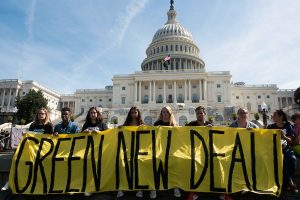June 30, 2020
By Kaitlyn Pohly
In a post-quarantine, shelter-in-place, mask-wearing world, what does the fate of our climate look like? Amidst all of this upheaval, it’s hard to remember that just half a year ago sustainability was a rising priority on the public’s agenda; the debate about the climate and its subsequent socioeconomic implications was gaining momentum.
Although the world’s shared media has been widely focused on the pandemic, it’s crucial that the pressure remain on the topic of climate change. And not only for the future of the planet—investments in sustainable, climate-resilient infrastructure and the transition to a lower-carbon society can significantly increase near-term job creation, a crucial factor in rebuilding our societies following the pandemic. Creating both
economic and environmental resilience in a post COVID-19 world is now more essential than ever.
However, what are the first steps? How can we go about continuing the never-ending process of transitioning our world to be more climate-conscious, especially after an event as catastrophic as the coronavirus pandemic? A key can come from understanding
the intersection and the similarities between the pandemic and continued climate risk.
Both of these issues represent
physical shocks, which means they have severe socioeconomic implications and impacts. The current pandemic already gave us an insight into what a damaged supply chain looks like when COVID-related health risks took meat and poultry off supermarket shelves. Similarly, if climate change is not adequately and swiftly addressed, we stand to experience supply chain damages once again. Once an inevitable climate disaster hits a region, they may no longer have the financial capabilities to import and export globally needed resources, causing a physical shock to global markets.
As our climate situation increases in severity, many of the
communicative issues highlighted by the pandemic’s globally fragmented response will continue to be a problem in coming years.
The Missing Ingredient? An Ounce of Prevention
The COVID-19 outbreak highlighted the fact that our society is ill-equipped to tackle disasters of this scale. The coronavirus and its subsequent responses, or lack thereof, illustrate how expensive the failure to build resiliency is. Similarly, with climate change, the cost of a global crisis is bound to vastly exceed those of its prevention.
With these similarities in mind, how do we go about stopping a crisis before it grows out of control? How can we be proactive? Before the pandemic, many signs of healthcare discrepancies were evident globally, and particularly in the United States. Data published by the
Commonwealth Fund highlighted that “… in the United States, workforce and acute hospital bed capacity is lower than in many [other] countries examined (such as Australia, Norway, and South Korea). This suggests that U.S. health care resources will be stretched to a greater extent than those of many other countries.” However, “despite a smaller supply of acute hospital beds, the U.S. has a lower occupancy rate of these beds, signaling greater capacity to deal with public health emergencies.” Despite less frequent hospitalizations of citizens prior to the pandemic, there was still significant evidence of fractures within the healthcare system.
These early warning signs are also already present in terms of climate risk. Island nations are struggling with rising sea levels,
methane levels are at an all-time high, and
permafrost is thawing at an increasingly worrisome pace. Rather than letting issues such as these escalate to a point of no return, it is up to the global community, organizations like the
United Nations Environmental Programme, and national governments to address the climate issues most pressing to them. By acting proactively instead of reactively, such as with the coronavirus pandemic, we can mitigate the impact of many disasters before they fully evolve.
The Path to Recovery: Treating Both Crises at Once
The United States, at least at the local level, has already begun to return the focus to climate risk mitigation and legislation following the pandemic. New York State and
New York City remain committed to recently passed climate legislation, and the
New York State Climate Action Council (NYSCAC) is working on a revised plan in the wake of the virus to achieve the goals of clean energy and sustainable climate agendas. The state even created a separate group on June 23, the
Climate Justice Working Group, to assist in this transition.

Kevin Wolf/Associated Press
From a national perspective, politicians running for office have stressed that the Green New Deal and other climate-oriented legislation is a top priority for them. There have been repeated calls for the adoption of
green stimulus programs in the wake of COVID economic recovery. Members of congress, led by Oregon’s 4th District Representative Peter DeFazio, have put forward an
infrastructure bill to foster the creation of millions of green jobs while divesting from fossil fuels. On June 30, House Speaker Nancy Pelosi (D-Calif.) and Rep. Kathy Castor (D-Fla.) released a
package of climate proposals that calls for government mandates, tax incentives and new infrastructure.
A green economic recovery for the virus essentially calls for policy-makers and local governments to keep in mind our long-term goals for climate crisis mitigation when crafting their pandemic responses. This would include direct support for zero-emission technologies and infrastructure, financial incentives, and even landscape restoration.
As humans, we tend to look to solve the immediate issues before us rather than think long term, but the pandemic is teaching us how critical it is to take the longer view. While it’s unclear how dramatically the lockdowns may have affected the actual climate itself, the conversations that have resulted from the pandemic have turned out to be a lesson for hastening our response to our climate’s rapidly changing nature.
Join GreenHomeNYC online this month.
July 7–Green Careers: Vocational Jobs
July 15–Monthly Forum: Urban Heat Island and COVID-19—A Perfect Storm?
*Photo Credit